light MAZDA MODEL MAZDASPEED 3 2007 (in English) Workshop Manual
[x] Cancel search | Manufacturer: MAZDA, Model Year: 2007, Model line: MODEL MAZDASPEED 3, Model: MAZDA MODEL MAZDASPEED 3 2007Pages: 402, PDF Size: 7.08 MB
Page 130 of 402
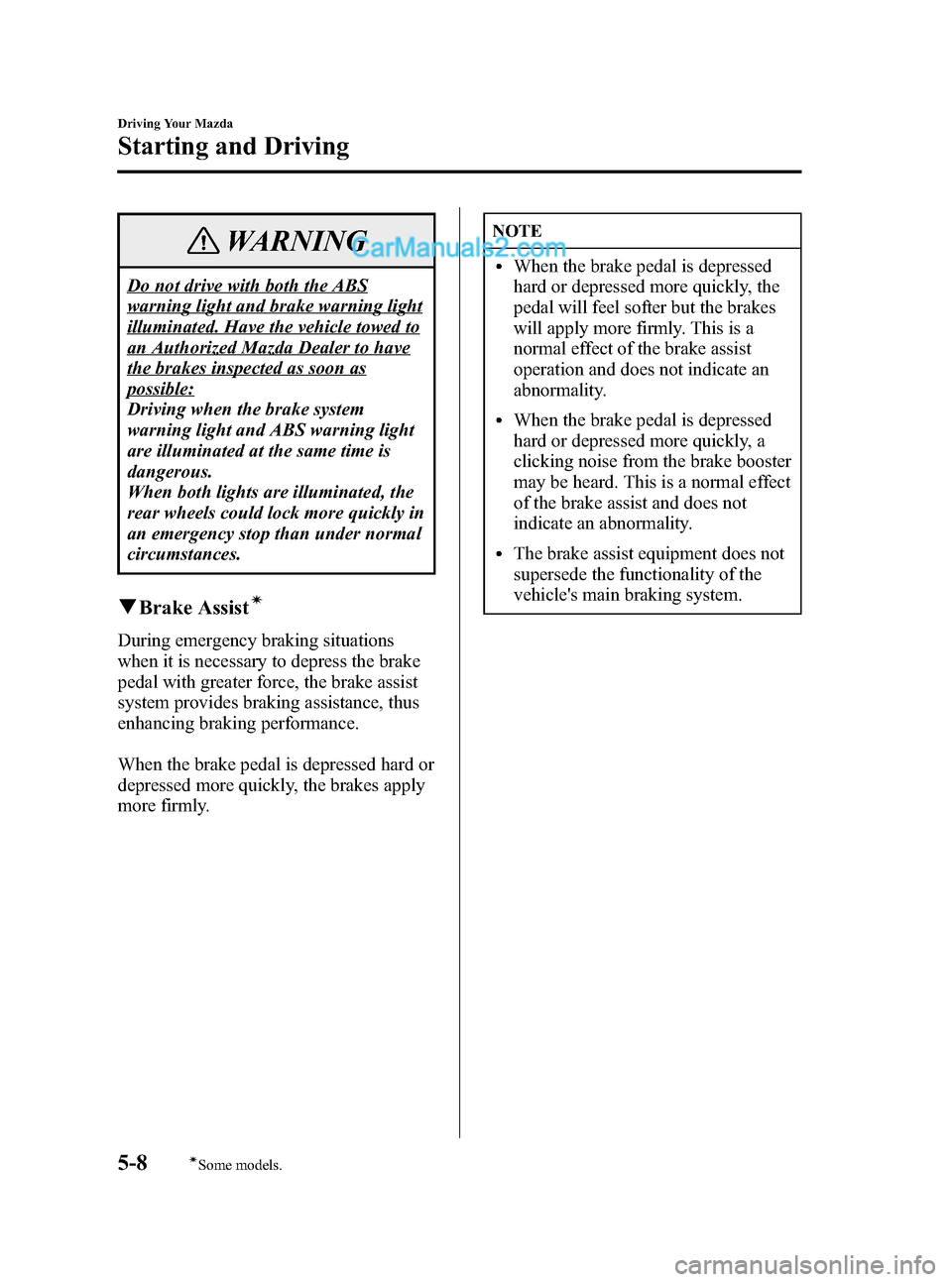
Black plate (130,1)
WARNING
Do not drive with both the ABS
warning light and brake warning light
illuminated. Have the vehicle towed to
an Authorized Mazda Dealer to have
the brakes inspected as soon as
possible:
Driving when the brake system
warning light and ABS warning light
are illuminated at the same time is
dangerous.
When both lights are illuminated, the
rear wheels could lock more quickly in
an emergency stop than under normal
circumstances.
qBrake Assistí
During emergency braking situations
when it is necessary to depress the brake
pedal with greater force, the brake assist
system provides braking assistance, thus
enhancing braking performance.
When the brake pedal is depressed hard or
depressed more quickly, the brakes apply
more firmly.
NOTE
lWhen the brake pedal is depressed
hard or depressed more quickly, the
pedal will feel softer but the brakes
will apply more firmly. This is a
normal effect of the brake assist
operation and does not indicate an
abnormality.
lWhen the brake pedal is depressed
hard or depressed more quickly, a
clicking noise from the brake booster
may be heard. This is a normal effect
of the brake assist and does not
indicate an abnormality.
lThe brake assist equipment does not
supersede the functionality of the
vehicle's main braking system.
5-8
Driving Your Mazda
íSome models.
Starting and Driving
Mazda3_8V66-EA-06F_Edition3 Page130
Wednesday, August 23 2006 11:19 AM
Form No.8V66-EA-06F
Page 134 of 402
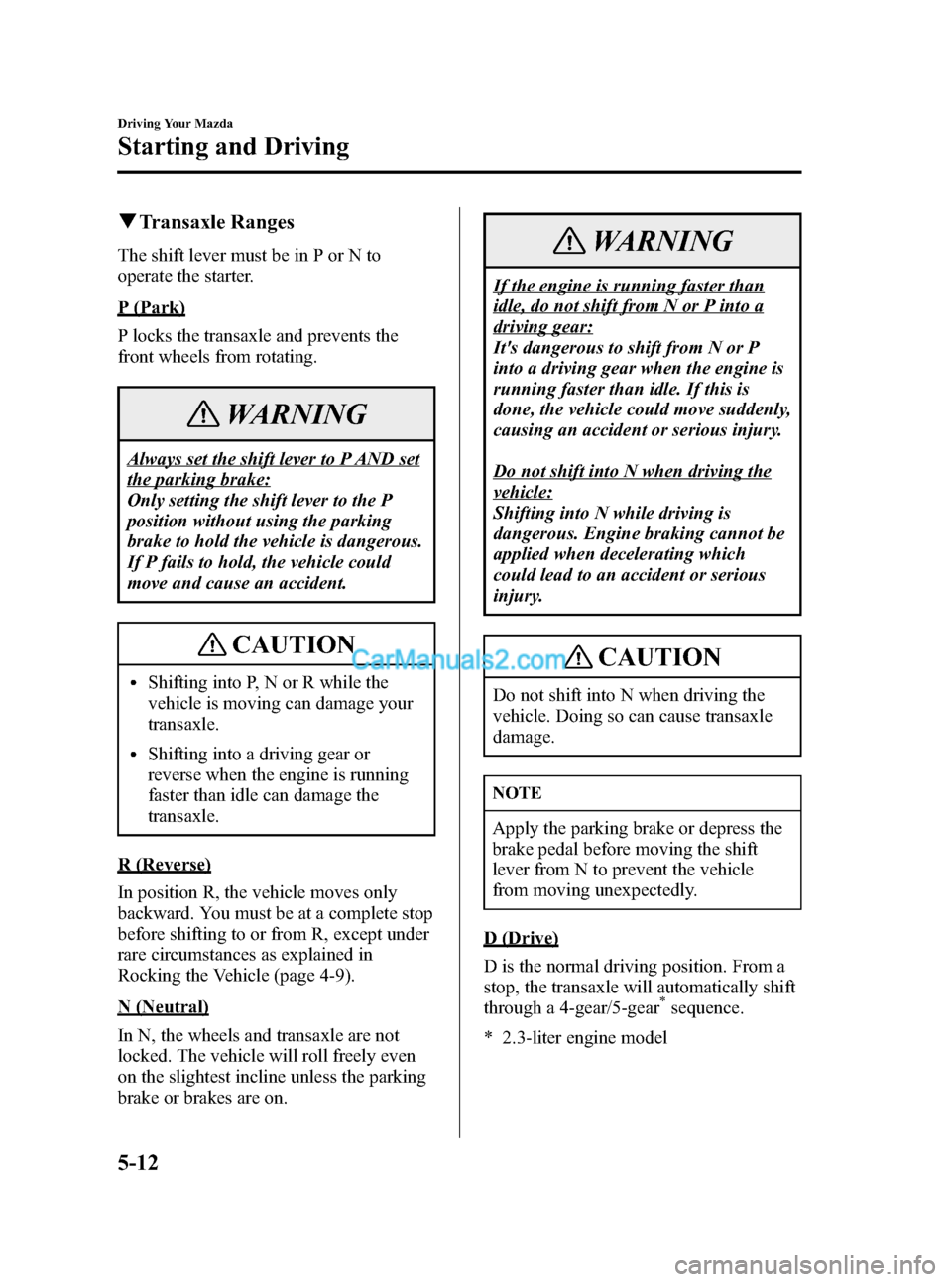
Black plate (134,1)
qTransaxle Ranges
The shift lever must be in P or N to
operate the starter.
P (Park)
P locks the transaxle and prevents the
front wheels from rotating.
WARNING
Always set the shift lever to P AND set
the parking brake:
Only setting the shift lever to the P
position without using the parking
brake to hold the vehicle is dangerous.
If P fails to hold, the vehicle could
move and cause an accident.
CAUTION
lShifting into P, N or R while the
vehicle is moving can damage your
transaxle.
lShifting into a driving gear or
reverse when the engine is running
faster than idle can damage the
transaxle.
R (Reverse)
In position R, the vehicle moves only
backward. You must be at a complete stop
before shifting to or from R, except under
rare circumstances as explained in
Rocking the Vehicle (page 4-9).
N (Neutral)
In N, the wheels and transaxle are not
locked. The vehicle will roll freely even
on the slightest incline unless the parking
brake or brakes are on.
WARNING
If the engine is running faster than
idle, do not shift from N or P into a
driving gear:
It's dangerous to shift from N or P
into a driving gear when the engine is
running faster than idle. If this is
done, the vehicle could move suddenly,
causing an accident or serious injury.
Do not shift into N when driving the
vehicle:
Shifting into N while driving is
dangerous. Engine braking cannot be
applied when decelerating which
could lead to an accident or serious
injury.
CAUTION
Do not shift into N when driving the
vehicle. Doing so can cause transaxle
damage.
NOTE
Apply the parking brake or depress the
brake pedal before moving the shift
lever from N to prevent the vehicle
from moving unexpectedly.
D (Drive)
D is the normal driving position. From a
stop, the transaxle will automatically shift
through a 4-gear/5-gear
*sequence.
* 2.3-liter engine model
5-12
Driving Your Mazda
Starting and Driving
Mazda3_8V66-EA-06F_Edition3 Page134
Wednesday, August 23 2006 11:19 AM
Form No.8V66-EA-06F
Page 140 of 402

Black plate (140,1)
Power Steering
Power steering is only operable when the
engine is running. If the engine is off or if
the power steering system is inoperable,
you can still steer, but it requires more
physical effort.
If the steering feels stiffer than usual
during normal driving, consult an
Authorized Mazda Dealer.
CAUTION
Never hold the steering wheel to the
extreme left or right for more than 5
seconds with the engine running.
This could damage the power steering
system.
qPower Steering Malfunction
Indicator Lightí
This indicator light illuminates when the
ignition switch is turned to the ON
position and goes off when the engine is
started.If the light stays illuminated after the
engine is started or illuminates while
driving, turn off the engine after parking
in a safe place, and then start the engine
again.
If the light does not illuminate after
restarting the engine, this indicates that
the power steering is restored and normal
steering is possible.
If the light remains illuminated, the power
steering is still inoperable. Consult an
Authorized Mazda Dealer.
NOTE
The power steering system is inoperable
when the power steering malfunction
indicator light illuminates. Steering is
possible, but requires more physical
effort.
5-18
Driving Your Mazda
íSome models.
Starting and Driving
Mazda3_8V66-EA-06F_Edition3 Page140
Wednesday, August 23 2006 11:19 AM
Form No.8V66-EA-06F
Page 141 of 402
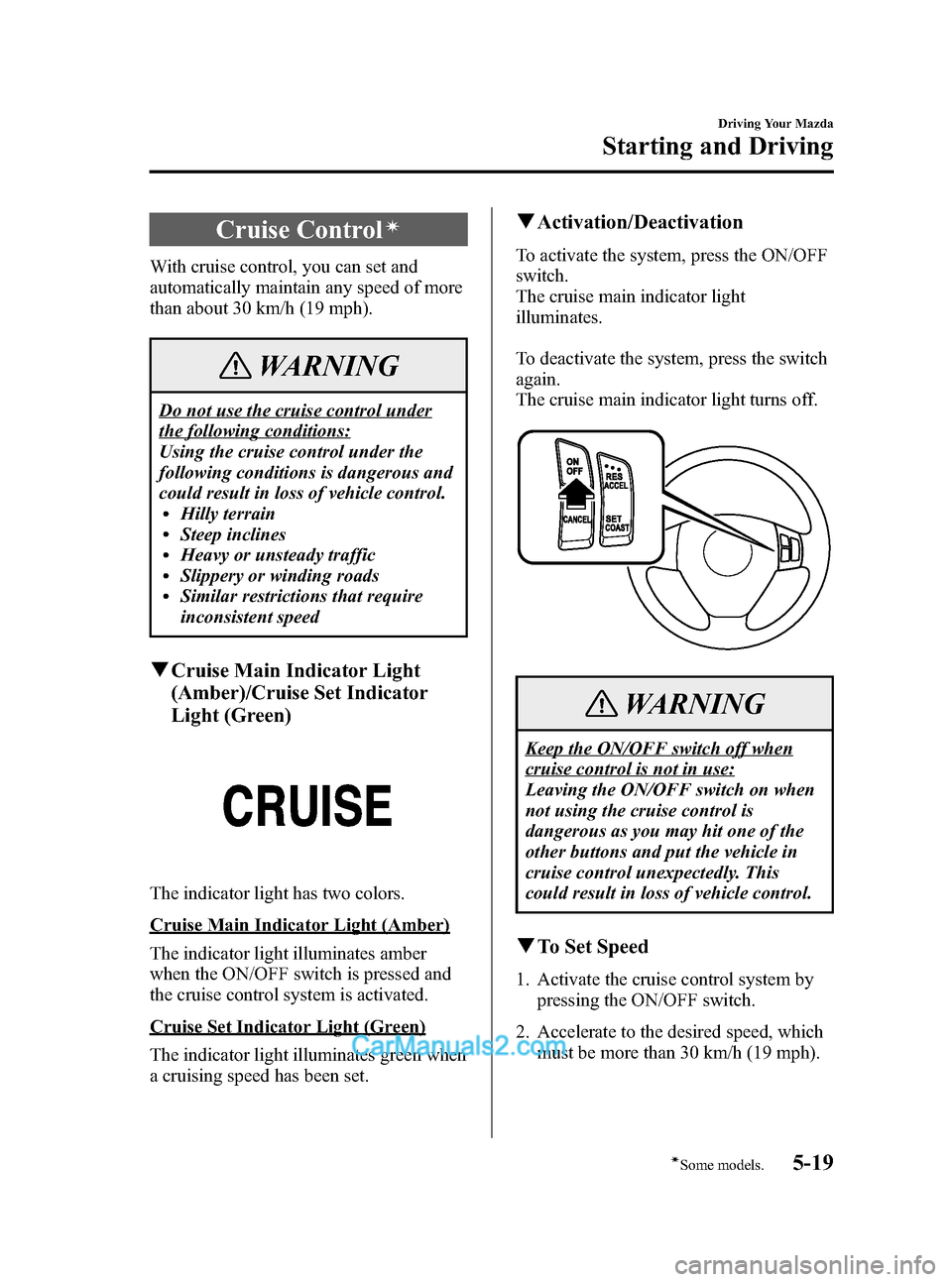
Black plate (141,1)
Cruise Controlí
With cruise control, you can set and
automatically maintain any speed of more
than about 30 km/h (19 mph).
WARNING
Do not use the cruise control under
the following conditions:
Using the cruise control under the
following conditions is dangerous and
could result in loss of vehicle control.
lHilly terrainlSteep inclineslHeavy or unsteady trafficlSlippery or winding roadslSimilar restrictions that require
inconsistent speed
qCruise Main Indicator Light
(Amber)/Cruise Set Indicator
Light (Green)
The indicator light has two colors.
Cruise Main Indicator Light (Amber)
The indicator light illuminates amber
when the ON/OFF switch is pressed and
the cruise control system is activated.
Cruise Set Indicator Light (Green)
The indicator light illuminates green when
a cruising speed has been set.
qActivation/Deactivation
To activate the system, press the ON/OFF
switch.
The cruise main indicator light
illuminates.
To deactivate the system, press the switch
again.
The cruise main indicator light turns off.
WARNING
Keep the ON/OFF switch off when
cruise control is not in use:
Leaving the ON/OFF switch on when
not using the cruise control is
dangerous as you may hit one of the
other buttons and put the vehicle in
cruise control unexpectedly. This
could result in loss of vehicle control.
qTo Set Speed
1. Activate the cruise control system by
pressing the ON/OFF switch.
2. Accelerate to the desired speed, which
must be more than 30 km/h (19 mph).
Driving Your Mazda
Starting and Driving
5-19íSome models. Mazda3_8V66-EA-06F_Edition3 Page141
Wednesday, August 23 2006 11:19 AM
Form No.8V66-EA-06F
Page 143 of 402
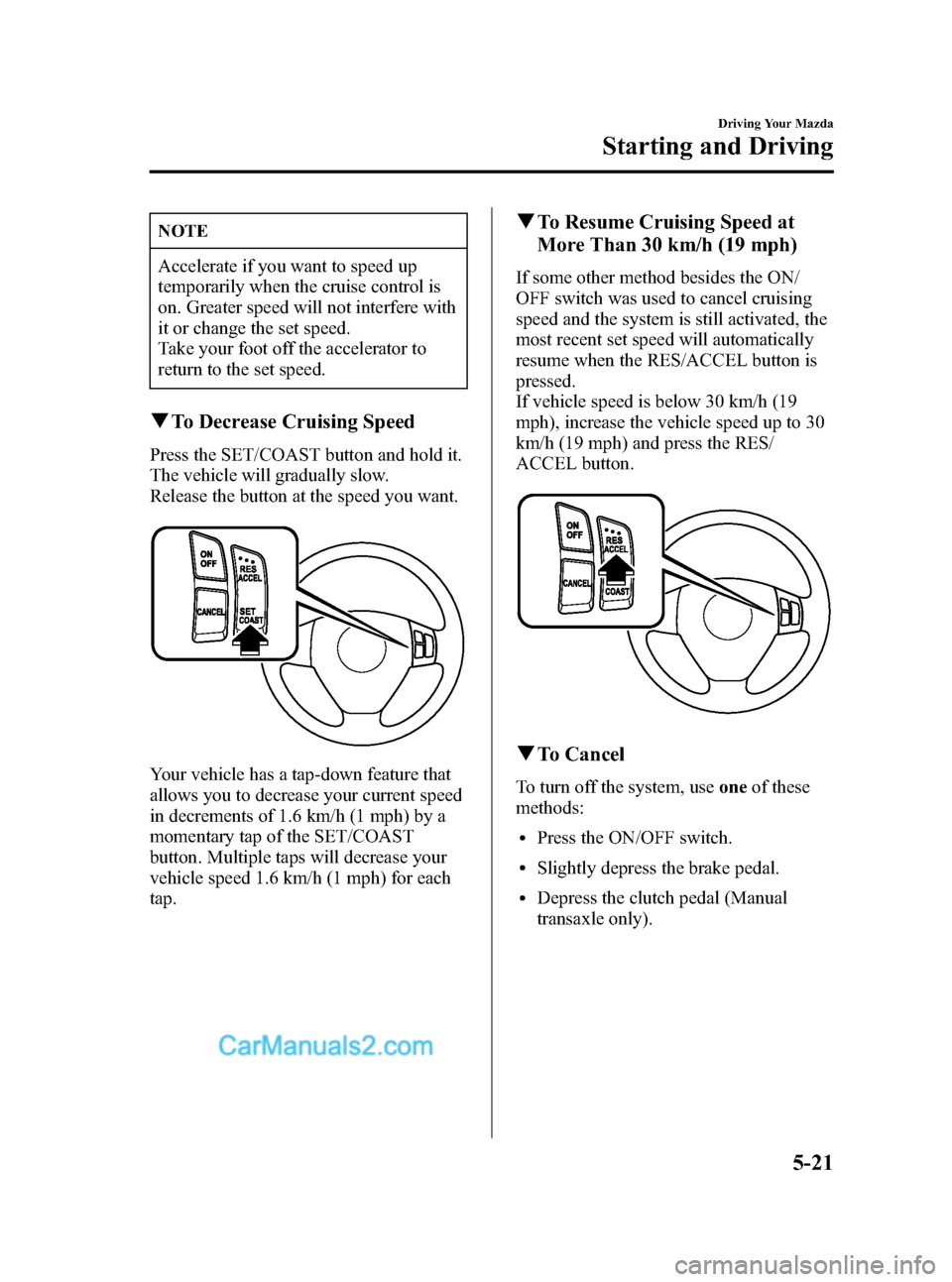
Black plate (143,1)
NOTE
Accelerate if you want to speed up
temporarily when the cruise control is
on. Greater speed will not interfere with
it or change the set speed.
Take your foot off the accelerator to
return to the set speed.
qTo Decrease Cruising Speed
Press the SET/COAST button and hold it.
The vehicle will gradually slow.
Release the button at the speed you want.
Your vehicle has a tap-down feature that
allows you to decrease your current speed
in decrements of 1.6 km/h (1 mph) by a
momentary tap of the SET/COAST
button. Multiple taps will decrease your
vehicle speed 1.6 km/h (1 mph) for each
tap.
qTo Resume Cruising Speed at
More Than 30 km/h (19 mph)
If some other method besides the ON/
OFF switch was used to cancel cruising
speed and the system is still activated, the
most recent set speed will automatically
resume when the RES/ACCEL button is
pressed.
If vehicle speed is below 30 km/h (19
mph), increase the vehicle speed up to 30
km/h (19 mph) and press the RES/
ACCEL button.
qTo Cancel
To turn off the system, useoneof these
methods:
lPress the ON/OFF switch.
lSlightly depress the brake pedal.
lDepress the clutch pedal (Manual
transaxle only).
Driving Your Mazda
Starting and Driving
5-21
Mazda3_8V66-EA-06F_Edition3 Page143
Wednesday, August 23 2006 11:19 AM
Form No.8V66-EA-06F
Page 145 of 402
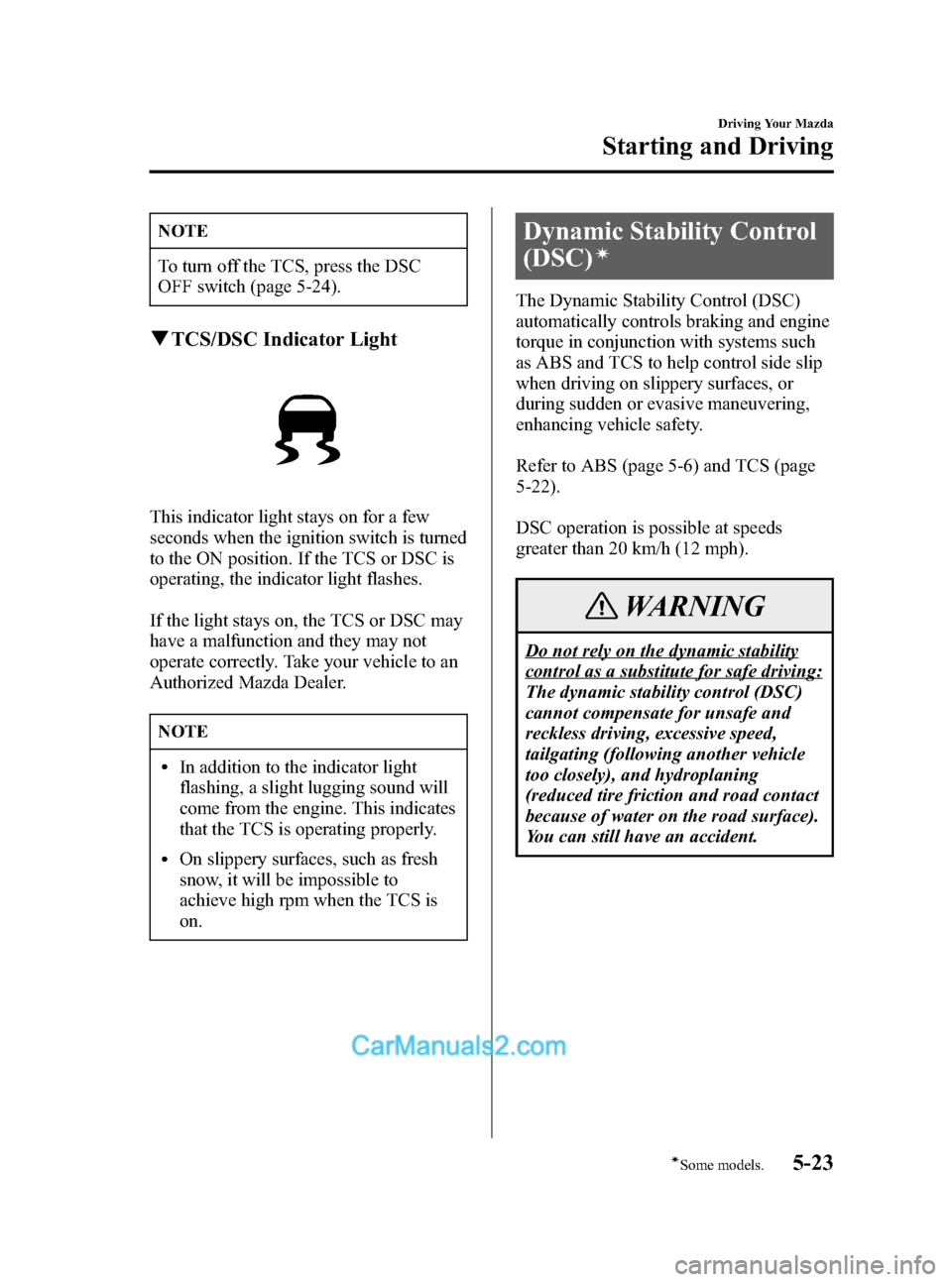
Black plate (145,1)
NOTE
To turn off the TCS, press the DSC
OFF switch (page 5-24).
qTCS/DSC Indicator Light
This indicator light stays on for a few
seconds when the ignition switch is turned
to the ON position. If the TCS or DSC is
operating, the indicator light flashes.
If the light stays on, the TCS or DSC may
have a malfunction and they may not
operate correctly. Take your vehicle to an
Authorized Mazda Dealer.
NOTE
lIn addition to the indicator light
flashing, a slight lugging sound will
come from the engine. This indicates
that the TCS is operating properly.
lOn slippery surfaces, such as fresh
snow, it will be impossible to
achieve high rpm when the TCS is
on.
Dynamic Stability Control
(DSC)
í
The Dynamic Stability Control (DSC)
automatically controls braking and engine
torque in conjunction with systems such
as ABS and TCS to help control side slip
when driving on slippery surfaces, or
during sudden or evasive maneuvering,
enhancing vehicle safety.
Refer to ABS (page 5-6) and TCS (page
5-22).
DSC operation is possible at speeds
greater than 20 km/h (12 mph).
WARNING
Do not rely on the dynamic stability
control as a substitute for safe driving:
The dynamic stability control (DSC)
cannot compensate for unsafe and
reckless driving, excessive speed,
tailgating (following another vehicle
too closely), and hydroplaning
(reduced tire friction and road contact
because of water on the road surface).
You can still have an accident.
Driving Your Mazda
Starting and Driving
5-23íSome models. Mazda3_8V66-EA-06F_Edition3 Page145
Wednesday, August 23 2006 11:19 AM
Form No.8V66-EA-06F
Page 146 of 402
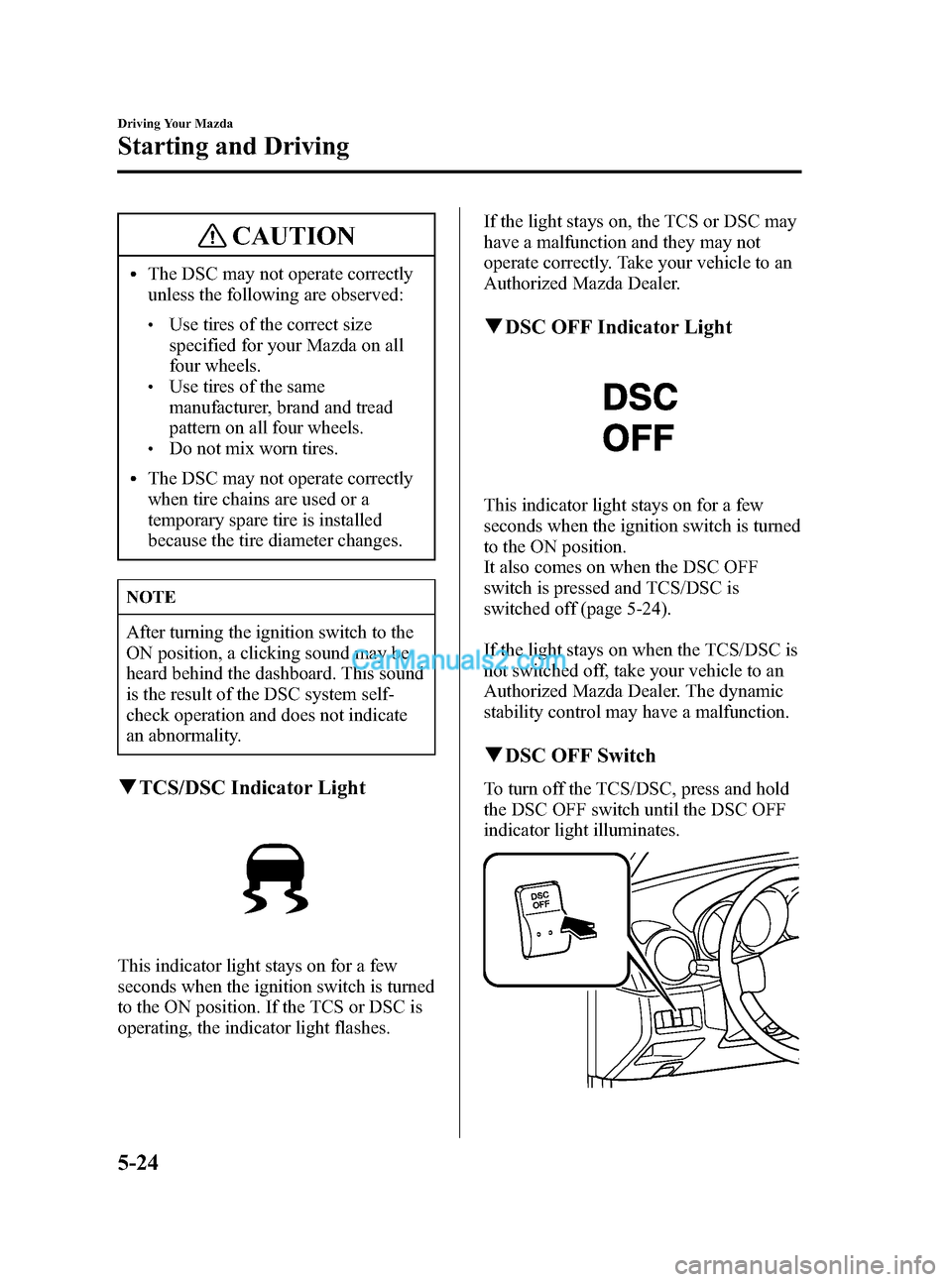
Black plate (146,1)
CAUTION
lThe DSC may not operate correctly
unless the following are observed:
lUse tires of the correct size
specified for your Mazda on all
four wheels.
lUse tires of the same
manufacturer, brand and tread
pattern on all four wheels.
lDo not mix worn tires.
lThe DSC may not operate correctly
when tire chains are used or a
temporary spare tire is installed
because the tire diameter changes.
NOTE
After turning the ignition switch to the
ON position, a clicking sound may be
heard behind the dashboard. This sound
is the result of the DSC system self-
check operation and does not indicate
an abnormality.
qTCS/DSC Indicator Light
This indicator light stays on for a few
seconds when the ignition switch is turned
to the ON position. If the TCS or DSC is
operating, the indicator light flashes.If the light stays on, the TCS or DSC may
have a malfunction and they may not
operate correctly. Take your vehicle to an
Authorized Mazda Dealer.
qDSC OFF Indicator Light
This indicator light stays on for a few
seconds when the ignition switch is turned
to the ON position.
It also comes on when the DSC OFF
switch is pressed and TCS/DSC is
switched off (page 5-24).
If the light stays on when the TCS/DSC is
not switched off, take your vehicle to an
Authorized Mazda Dealer. The dynamic
stability control may have a malfunction.
qDSC OFF Switch
To turn off the TCS/DSC, press and hold
the DSC OFF switch until the DSC OFF
indicator light illuminates.
5-24
Driving Your Mazda
Starting and Driving
Mazda3_8V66-EA-06F_Edition3 Page146
Wednesday, August 23 2006 11:19 AM
Form No.8V66-EA-06F
Page 147 of 402
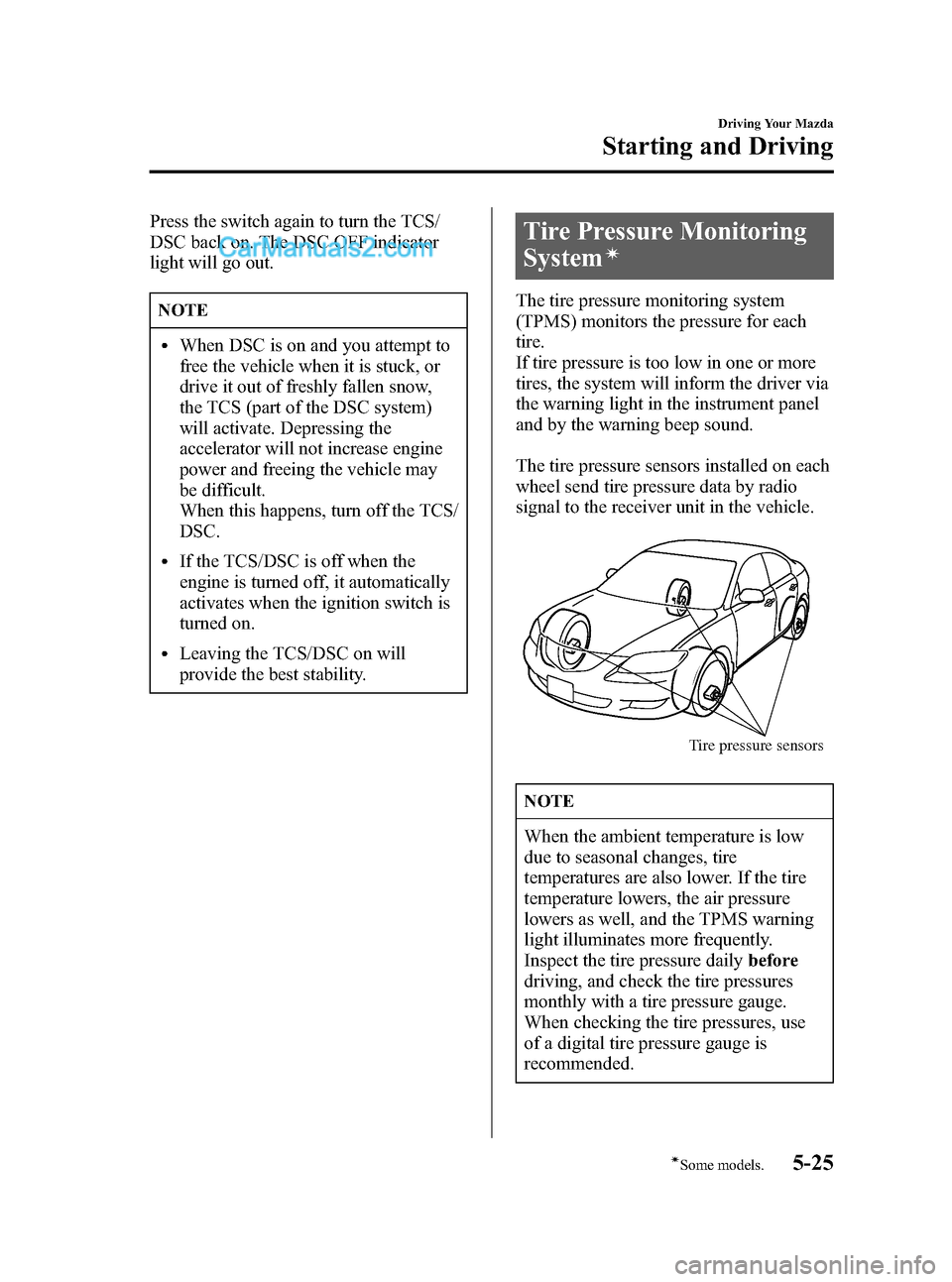
Black plate (147,1)
Press the switch again to turn the TCS/
DSC back on. The DSC OFF indicator
light will go out.
NOTE
lWhen DSC is on and you attempt to
free the vehicle when it is stuck, or
drive it out of freshly fallen snow,
the TCS (part of the DSC system)
will activate. Depressing the
accelerator will not increase engine
power and freeing the vehicle may
be difficult.
When this happens, turn off the TCS/
DSC.
lIf the TCS/DSC is off when the
engine is turned off, it automatically
activates when the ignition switch is
turned on.
lLeaving the TCS/DSC on will
provide the best stability.
Tire Pressure Monitoring
System
í
The tire pressure monitoring system
(TPMS) monitors the pressure for each
tire.
If tire pressure is too low in one or more
tires, the system will inform the driver via
the warning light in the instrument panel
and by the warning beep sound.
The tire pressure sensors installed on each
wheel send tire pressure data by radio
signal to the receiver unit in the vehicle.
Tire pressure sensors
NOTE
When the ambient temperature is low
due to seasonal changes, tire
temperatures are also lower. If the tire
temperature lowers, the air pressure
lowers as well, and the TPMS warning
light illuminates more frequently.
Inspect the tire pressure dailybefore
driving, and check the tire pressures
monthly with a tire pressure gauge.
When checking the tire pressures, use
of a digital tire pressure gauge is
recommended.
Driving Your Mazda
Starting and Driving
5-25íSome models. Mazda3_8V66-EA-06F_Edition3 Page147
Wednesday, August 23 2006 11:19 AM
Form No.8V66-EA-06F
Page 149 of 402
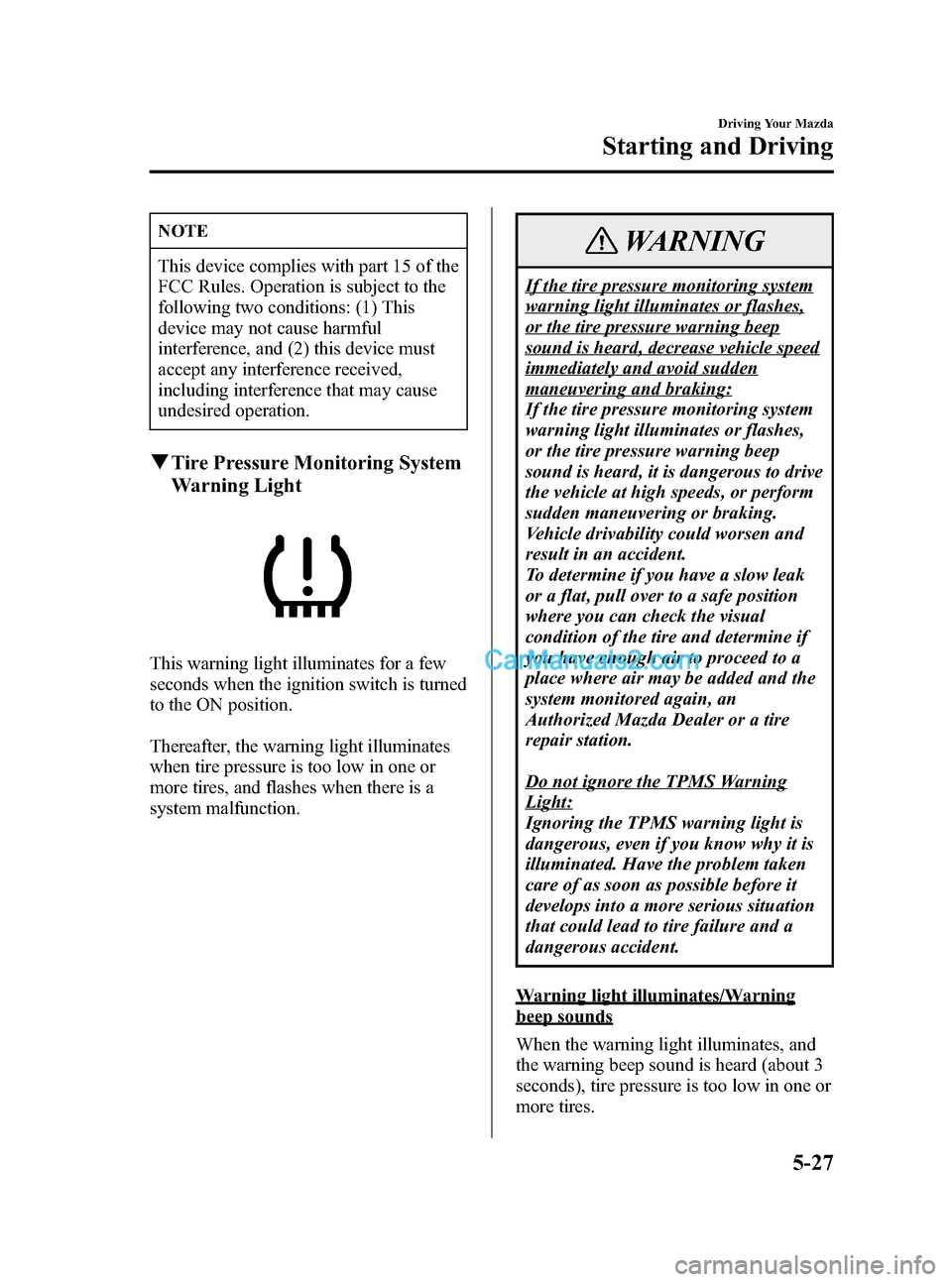
Black plate (149,1)
NOTE
This device complies with part 15 of the
FCC Rules. Operation is subject to the
following two conditions: (1) This
device may not cause harmful
interference, and (2) this device must
accept any interference received,
including interference that may cause
undesired operation.
qTire Pressure Monitoring System
Warning Light
This warning light illuminates for a few
seconds when the ignition switch is turned
to the ON position.
Thereafter, the warning light illuminates
when tire pressure is too low in one or
more tires, and flashes when there is a
system malfunction.
WARNING
If the tire pressure monitoring system
warning light illuminates or flashes,
or the tire pressure warning beep
sound is heard, decrease vehicle speed
immediately and avoid sudden
maneuvering and braking:
If the tire pressure monitoring system
warning light illuminates or flashes,
or the tire pressure warning beep
sound is heard, it is dangerous to drive
the vehicle at high speeds, or perform
sudden maneuvering or braking.
Vehicle drivability could worsen and
result in an accident.
To determine if you have a slow leak
or a flat, pull over to a safe position
where you can check the visual
condition of the tire and determine if
you have enough air to proceed to a
place where air may be added and the
system monitored again, an
Authorized Mazda Dealer or a tire
repair station.
Do not ignore the TPMS Warning
Light:
Ignoring the TPMS warning light is
dangerous, even if you know why it is
illuminated. Have the problem taken
care of as soon as possible before it
develops into a more serious situation
that could lead to tire failure and a
dangerous accident.
Warning light illuminates/Warning
beep sounds
When the warning light illuminates, and
the warning beep sound is heard (about 3
seconds), tire pressure is too low in one or
more tires.
Driving Your Mazda
Starting and Driving
5-27
Mazda3_8V66-EA-06F_Edition3 Page149
Wednesday, August 23 2006 11:19 AM
Form No.8V66-EA-06F
Page 150 of 402
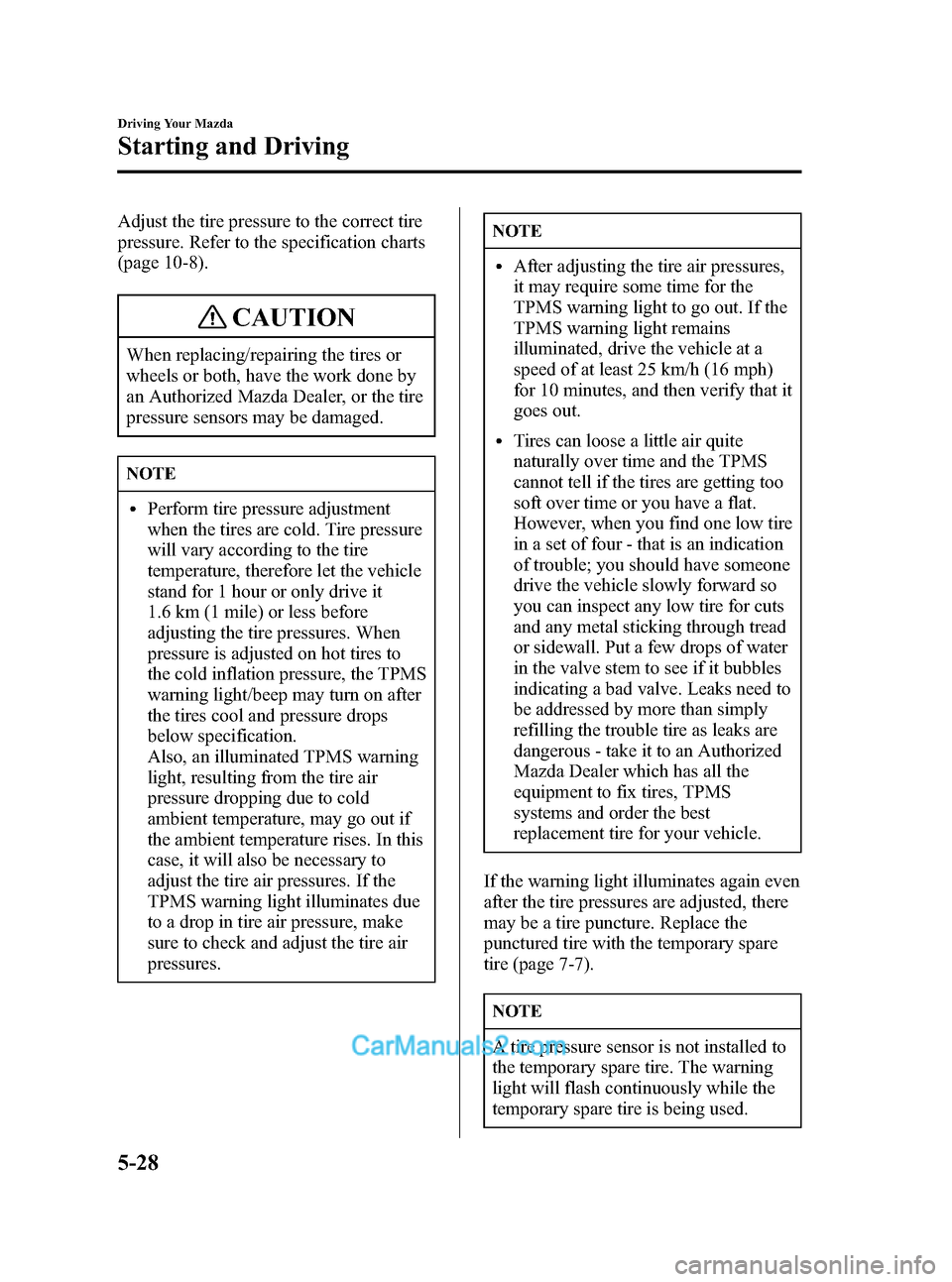
Black plate (150,1)
Adjust the tire pressure to the correct tire
pressure. Refer to the specification charts
(page 10-8).
CAUTION
When replacing/repairing the tires or
wheels or both, have the work done by
an Authorized Mazda Dealer, or the tire
pressure sensors may be damaged.
NOTE
lPerform tire pressure adjustment
when the tires are cold. Tire pressure
will vary according to the tire
temperature, therefore let the vehicle
stand for 1 hour or only drive it
1.6 km (1 mile) or less before
adjusting the tire pressures. When
pressure is adjusted on hot tires to
the cold inflation pressure, the TPMS
warning light/beep may turn on after
the tires cool and pressure drops
below specification.
Also, an illuminated TPMS warning
light, resulting from the tire air
pressure dropping due to cold
ambient temperature, may go out if
the ambient temperature rises. In this
case, it will also be necessary to
adjust the tire air pressures. If the
TPMS warning light illuminates due
to a drop in tire air pressure, make
sure to check and adjust the tire air
pressures.
NOTE
lAfter adjusting the tire air pressures,
it may require some time for the
TPMS warning light to go out. If the
TPMS warning light remains
illuminated, drive the vehicle at a
speed of at least 25 km/h (16 mph)
for 10 minutes, and then verify that it
goes out.
lTires can loose a little air quite
naturally over time and the TPMS
cannot tell if the tires are getting too
soft over time or you have a flat.
However, when you find one low tire
in a set of four - that is an indication
of trouble; you should have someone
drive the vehicle slowly forward so
you can inspect any low tire for cuts
and any metal sticking through tread
or sidewall. Put a few drops of water
in the valve stem to see if it bubbles
indicating a bad valve. Leaks need to
be addressed by more than simply
refilling the trouble tire as leaks are
dangerous - take it to an Authorized
Mazda Dealer which has all the
equipment to fix tires, TPMS
systems and order the best
replacement tire for your vehicle.
If the warning light illuminates again even
after the tire pressures are adjusted, there
may be a tire puncture. Replace the
punctured tire with the temporary spare
tire (page 7-7).
NOTE
A tire pressure sensor is not installed to
the temporary spare tire. The warning
light will flash continuously while the
temporary spare tire is being used.
5-28
Driving Your Mazda
Starting and Driving
Mazda3_8V66-EA-06F_Edition3 Page150
Wednesday, August 23 2006 11:19 AM
Form No.8V66-EA-06F